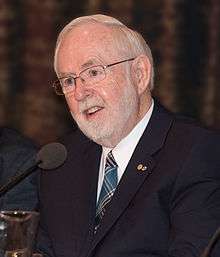Arthur B. McDonald
| Arthur B. McDonald CC OOnt FRS FRSC | |
|---|---|
 Arthur B. McDonald in Stockholm in December 2015 | |
| Born |
Arthur Bruce McDonald August 29, 1943 Sydney, Nova Scotia |
| Residence | Kingston, Ontario |
| Nationality | Canadian |
| Fields | Astrophysics |
| Institutions | |
| Alma mater |
|
| Thesis | Excitation energies and decay properties of T = 3/2 states in 17O, 17F and 21Na. (1970) |
| Doctoral advisor | William Alfred Fowler |
| Known for | Solving the solar neutrino problem |
| Notable awards |
|
|
Website queensu | |
Arthur Bruce McDonald, CC OOnt FRS FRSC (born August 29, 1943) is a Canadian astrophysicist. McDonald is the director of the Sudbury Neutrino Observatory Institute and holds the Gordon and Patricia Gray Chair in Particle Astrophysics at Queen's University in Kingston, Ontario. He was awarded the 2015 Nobel Prize in Physics jointly with Japanese physicist Takaaki Kajita.
Early life
McDonald was born on August 29, 1943,[1] in Sydney, Nova Scotia.[3] He graduated with a B.Sc. in physics in 1964 and M.Sc. in physics in 1965 from Dalhousie University in Nova Scotia.[4] He then obtained his Ph.D. in physics in 1969 from the California Institute of Technology.[5]
Academic career
McDonald worked as a research officer at the Chalk River Nuclear Laboratories northwest of Ottawa from 1970 to 1982. He became professor of physics at Princeton University from 1982 to 1989, leaving Princeton to join Queen's University. He is currently the University Research Chair at Queen's University and a board member at Perimeter Institute for Theoretical Physics.[4][6][7]
Research

Physicists have been investigating whether or not neutrinos have mass. Since the late 1960s, experiments have hinted that neutrinos may have mass. Theoretical models of the Sun predict that neutrinos should be made in staggering numbers. Neutrino detectors on the Earth have repeatedly seen fewer than the expected number of neutrinos. Because neutrinos come in three varieties (electron, muon, and tau neutrinos), and because solar neutrino detectors have been primarily sensitive only to electron neutrinos, the preferred explanation over the years is that those "missing" neutrinos had changed, or oscillated, into a variety for which the detectors had little or no sensitivity. If a neutrino oscillates, according to the laws of quantum mechanics, then it must have a mass.[6]
In August 2001, a collaboration at the Sudbury Neutrino Observatory (SNO), a detector facility located 6,800 feet (2,100 m) underground in a mine outside Sudbury, Ontario, led by McDonald, checked in with a direct observation suggesting that electron neutrinos from the Sun really were oscillating into muon and tau neutrinos. SNO published its report in the August 13, 2001, issue of Physical Review Letters, and it is widely considered as a very important result. McDonald is a co-recipient of the 2007 Benjamin Franklin Medal in Physics, the 2015 Nobel Prize in Physics, and the 2015 Fundamental Physics Prize for the discovery of neutrino oscillations and demonstrating that neutrinos have mass.[5][8]
Honours and awards
- 2006, made an Officer of the Order of Canada[9]
- 2007, awarded the Benjamin Franklin Medal in Physics with Yoji Totsuka[5]
- 2009, elected a Fellow of the Royal Society (FRS) of London[2]
- 2010, awarded the Canada Council Killam Prize in Natural Sciences for lifetime achievement in the field
- 2011, awarded the Royal Society of Canada's Henry Marshall Tory Medal in recognition for having "brought great honour and intellectual wealth to Canada".[10]
- 2015, awarded the Nobel Prize in Physics jointly with Takaaki Kajita for the discovery of neutrino oscillations, which shows that neutrinos have mass.[11]
- 2015, promoted to Companion of the Order of Canada[12]
- 2016, awarded the Fundamental Physics Prize
- 2016, foreign associate of the National Academy of Sciences[13]
References
- 1 2 3 McDONALD, Prof. Arthur Bruce. Who's Who. 2015 (online Oxford University Press ed.). A & C Black, an imprint of Bloomsbury Publishing plc. (subscription required)
- 1 2 "Arthur McDonald biography". Royal Society. Retrieved 2015-10-09.
- ↑ "Past Winner 2003 NSERC Award of Excellence McDonald". Natural Sciences and Engineering Research Council of Canada. Retrieved 2012-09-21.
- 1 2 "CV Arthur B. McDonald" (PDF). www.queensu.ca.
- 1 2 3 "Arthur B. McDonald". www.fi.edu. The Franklin Institute. Retrieved 6 October 2015.
- 1 2 "Interview with Arthur B. McDonald". Archived from the original on 17 November 2007. Retrieved 2007-11-02.
- ↑ "Board of Directors". Perimeter Institute. 2012. Retrieved 2015-10-09.
- ↑ Spears, Tom (9 November 2015). "Neutrino Nobel winner Art McDonald nabs second big physics prize". Ottawa Citizen. Retrieved 9 November 2015.
- ↑ "Order of Canada citation".
- ↑ "Henry Marshall Tory Medal". Royal Society of Canada. Retrieved 2012-09-21.
- ↑ "The Nobel Prize in Physics 2015". www.nobelprize.org.
- ↑ "Order of Canada Appointments". The Governor General of Canada His Excellency the Right Honourable David Johnston. Governor General of Canada. Retrieved 31 December 2015.
- ↑ National Academy of Sciences Members and Foreign Associates Elected, News from the National Academy of Sciences, National Academy of Sciences, May 3, 2016, retrieved 2016-05-14.
